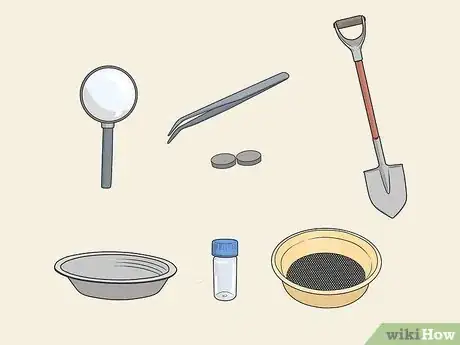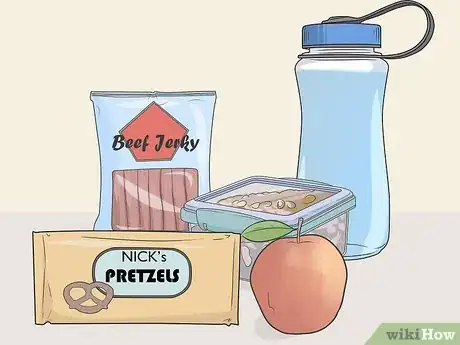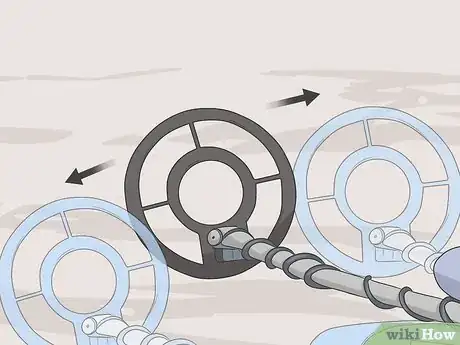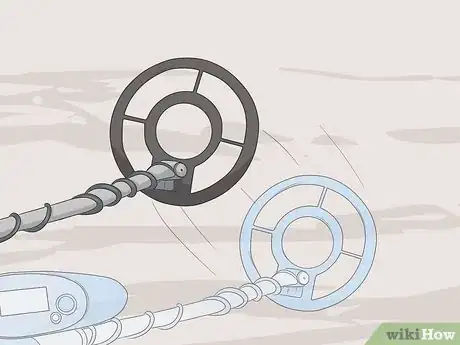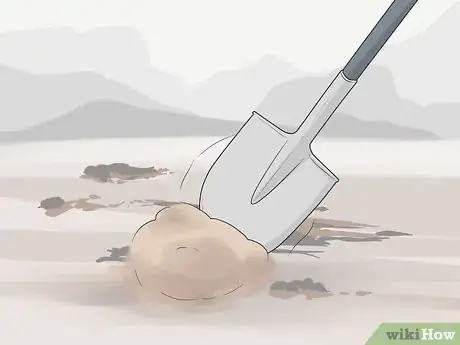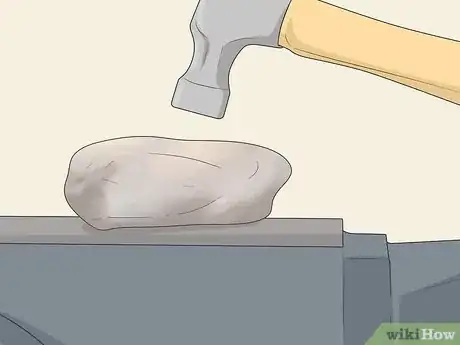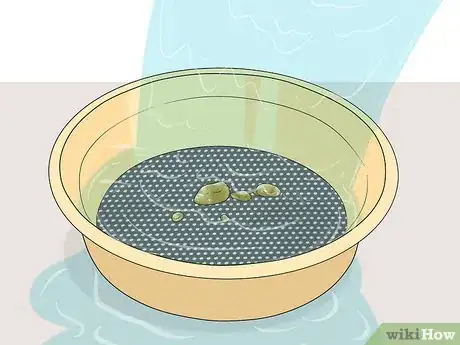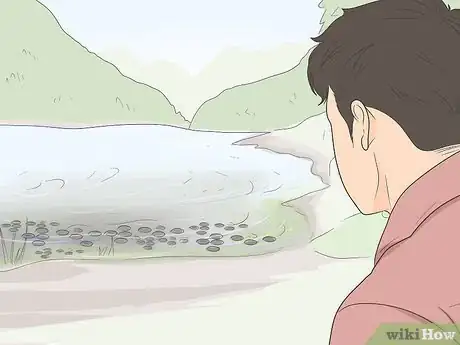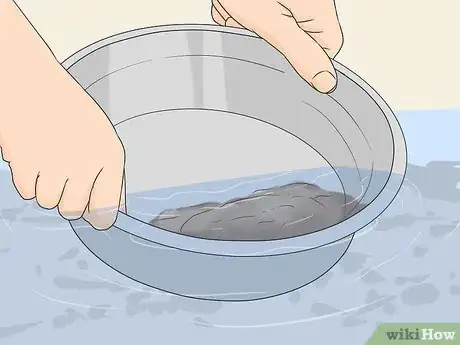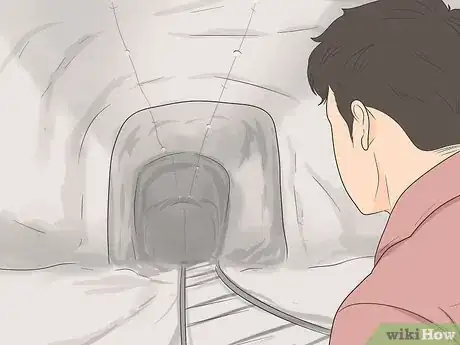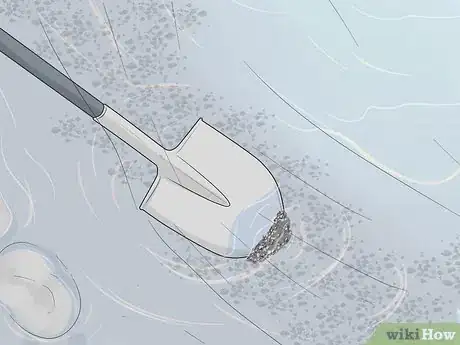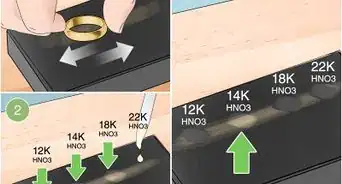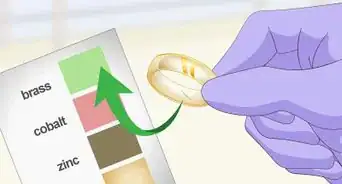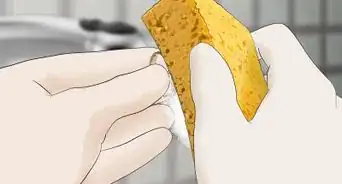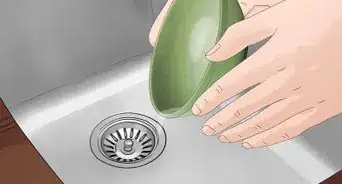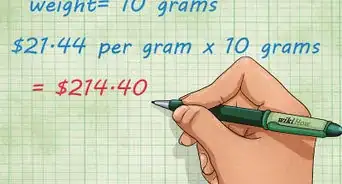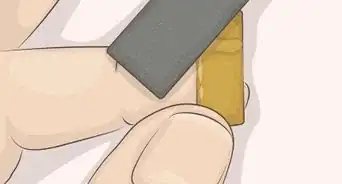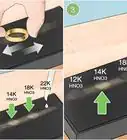This article was co-authored by wikiHow Staff. Our trained team of editors and researchers validate articles for accuracy and comprehensiveness. wikiHow's Content Management Team carefully monitors the work from our editorial staff to ensure that each article is backed by trusted research and meets our high quality standards.
There are 9 references cited in this article, which can be found at the bottom of the page.
This article has been viewed 240,459 times.
Learn more...
Planning a gold-hunting expedition is a lot like planning for a big hike, but with the potential for finding gold! Gather up the items you will need to go hunting for gold. Then, increase your chances of finding gold nuggets with a metal detector. You can also find gold nuggets by panning for it in areas where gold has been found in the past, such as old mines and streams where prospectors used to pan for gold.
Steps
Preparing to Hunt for Gold
-
1Gather materials for your gold-hunting expedition. You can hunt for gold with a simple gold pan and not much else. However, there are some other items that may make your expedition easier. Some items to pack for your gold-hunting expedition include:[1]
- Gold pan
- Shovel
- Grizzly pan (pan with holes in the bottom for sifting)
- Magnifying glass
- Tweezers
- Small magnet
- Glass vials to hold gold
-
2Dress appropriately for the weather and location. Wear something warm if the weather will be cold. Dress in layers so you can easily remove them if you become too warm. If the weather will be hot, opt for shorts and a T-shirt. Make sure to bring sunscreen as well to protect any uncovered skin. Some other items you might need include:[2]
- Rubber gloves
- Rubber boots
- Comfortable hiking shoes
- An extra pair of socks
- Winter coat or waterproof jacket
- Sunglasses
Advertisement -
3Pack snacks, water, and any other items you might need. Hunting for gold can take all day and it can be physically exhausting. Make sure that you bring plenty of water and food to keep you fueled for your gold-hunting activities. Some good options include:[3]
- Trail mix (dried fruit and nuts)
- Granola
- Pretzels
- Fresh fruit
- Jerky
- Thermos of coffee or an energy drink
-
4Research locations where gold has been found before. Your best chance for finding gold nuggets is to go to locations where other people have found gold before. Check online and talk with other people who have experience searching for gold nuggets. Also, check with your national, state or provincial geological survey office for information or maps.[4]
- You can also check online for maps to old gold mines.[5]
Tip: Places with the words “gold” or “golden” in them may be good places to search for gold.
Using a Metal Detector to Find Gold
-
1Purchase a metal detector to make it easier to find gold. Metal detectors are widely available and they make it much easier to find gold nuggets. Purchase a metal detector or build your own before you head out in search of gold nuggets. Get a metal detector that comes with headphones or use your own to make it easier to hear the tones.[6]
- Make sure that the metal detector you purchase or build can detect gold. There are also some special models of metal detectors available that are extra sensitive to gold.
-
2Learn how to use the metal detector properly. Read the instructions that came with your metal detector. If you purchase the metal detector in a store, you could also ask a salesperson to give you a demonstration before you leave.[7]
- You could also watch videos online for your specific type of metal detector.
-
3Sweep your metal detector from side-to-side just above the ground. Keep the metal detector low and sweep it gently from side to side. Avoid sweeping in a pendulum pattern high off the ground or you will miss sections of the ground in your search.
Tip: Try going metal detecting with a friend or family member. This way you can cover twice as much ground and ensure that you won’t miss any spot where gold might be hiding.[8]
-
4Perform overlapping sweeps to ensure full-coverage of an area. It’s important to double back and check the right beside the areas where you have just swept. Aim to overlap where you swept on the first pass by about 1 ft (0.30 m) to ensure that you don’t miss anything. If you do not slightly overlap your sweeps, then you may miss small deposits between swept areas.[9]
- Don’t stop searching an area until you have covered every section of it.
-
5Dig for gold in areas where your metal detector beeps. Use as rake to remove and loosen soil in layers or a shovel to dig deeper in the ground. If your metal detector has a feature that tells you how deep to dig, then dig to this level in the ground where the metal detector is beeping.[10]
- If you find a gold nugget, keep searching deeper and in the surrounding areas. Gold nuggets are often found in patches, so there might be more!
-
6Use a hammer and anvil to break up large rocks that may contain gold. If you find a rock that your metal detector indicates may have gold in it, place it on an anvil and hit it with a hammer. You may have to do this several times to break up the rock if it’s large.[11]
- Make sure to wear goggles and heavy leather gloves when you do this.
-
7Place smaller pieces of gold in a sifting pan and rinse with water. If you dig up small pieces of gold, rinse them in a sifting pan to remove dirt and debris. Pour excess water over the grooved edge of the pan slowly. This will help to ensure that you do not lose any pieces of gold that may be in the soil.[12]
- Use a blue sifting pan to make it easier to spot any gold that you find.
Panning for Gold
-
1Target rock outcroppings to find gold that is visible above ground. Look in the soil and in any water sources, such as shallow creeks and streams, below the outcropping. If any gold washed away from the rock outcropping, it may have embedded in the soil since gold is heavier than other minerals.[13]
- Granite, shale, and gneiss often contain gold, so try to target outcroppings made from these types of rocks.[14]
-
2Pan for gold in shallow areas of rivers and streams. Look for a shallow area of a river or stream, such as near the edges of the river. Dip your pan into the soil near the edge of the river and gently swish and sift it to remove the water. Gold is heavy, so it will sink to the bottom of the pan if there’s any in it. After the water is gone, check to see if the pan contains any gold.[15]
- Make sure to use a blue or green-colored gold pan. This will make it easier to spot any smaller pieces of gold that you find.
-
3Check the areas around old mines without entering them. Never enter an old mine as this can be very dangerous. However, you can search the areas around an old gold mine to look for gold. Check the roads leading to and from the mine as well as any nearby streams or rock outcroppings. If there’s any old equipment leftover from when the mine was being actively used, check around there as well.[16]
Warning: If you plan to look for gold nuggets on a piece of private property, make sure that you get written consent from the property owners before you begin.[17]
-
4Dig under pebbles on the edges of rivers and streams. Gold may lie just underneath pebbles along the edges of a river or stream as well. Gold is heavier than other types of minerals, so it sinks down and it might be in the soil just under the pebbles.[18]
- Try checking along the edges of a river bed or stream after a flood or heavy rain. You may have more luck finding gold after a heavy rainfall has shifted everything around.
Community Q&A
-
QuestionWhat are tailing piles?
 Community AnswerTailings are the larger stones left over from a previous mining operation, often found in a pile.
Community AnswerTailings are the larger stones left over from a previous mining operation, often found in a pile. -
QuestionHas there ever been an old volcano with natural gold?
 Community AnswerThe Galeras volcano is venting commercial amounts of gold from its fiery top.
Community AnswerThe Galeras volcano is venting commercial amounts of gold from its fiery top. -
QuestionWhat do I do with the nuggets I find?
 Community AnswerYou may purchase a smithing forge, and learn how to make something out of it, or you can put it on a shelf as decoration. You can be as creative as you want. Selling them is another option if you don't wish to keep them and you need some cash.
Community AnswerYou may purchase a smithing forge, and learn how to make something out of it, or you can put it on a shelf as decoration. You can be as creative as you want. Selling them is another option if you don't wish to keep them and you need some cash.
Warnings
- Do not prospect in national parks or in areas where you do not have permission to search. This could result in prospectors being banned from the lands altogether, which would be a negative consequence for all gold-hunting hobbyists.⧼thumbs_response⧽
Things You'll Need
- Gold pan
- Shovel
- Grizzly pan (pan with holes in the bottom for sifting)
- Magnifying glass
- Tweezers
- Small magnet
- Glass vials to hold gold
- Weather-appropriate clothing
- Rubber gloves
- Rubber boots
- Comfortable hiking shoes
- An extra pair of socks
- Winter coat or waterproof jacket
- Sunglasses
- Trail mix (dried fruit and nuts)
- Granola
- Pretzels
- Fresh fruit
- Jerky
- Thermos of coffee or an energy drink
- Water
- Metal detector
- Headphones
- Rake
- Hammer
- Anvil
References
- ↑ https://www.alaska.org/advice/gold-panning-equipment
- ↑ https://www.alaska.org/advice/gold-panning-equipment
- ↑ https://www.yosemite.com/packing-yosemite-day-hike/
- ↑ https://sciencing.com/gold-quartz-6519106.html
- ↑ https://goodmenproject.com/featured-content/best-30-gold-nugget-prospecting-tips-cmtt/
- ↑ https://sciencing.com/gold-quartz-6519106.html
- ↑ http://www.goldgold.com/tips-for-detecting-gold-nuggets.html
- ↑ https://goodmenproject.com/featured-content/best-30-gold-nugget-prospecting-tips-cmtt/
- ↑ https://goodmenproject.com/featured-content/best-30-gold-nugget-prospecting-tips-cmtt/
- ↑ https://goodmenproject.com/featured-content/best-30-gold-nugget-prospecting-tips-cmtt/
- ↑ https://sciencing.com/gold-quartz-6519106.html
- ↑ https://goodmenproject.com/featured-content/best-30-gold-nugget-prospecting-tips-cmtt/
- ↑ https://www.ga.gov.au/education/classroom-resources/minerals-energy/australian-mineral-facts/gold
- ↑ https://goodmenproject.com/featured-content/best-30-gold-nugget-prospecting-tips-cmtt/
- ↑ https://www.ga.gov.au/education/classroom-resources/minerals-energy/australian-mineral-facts/gold
- ↑ http://www.goldgold.com/tips-for-detecting-gold-nuggets.html
- ↑ https://geology.com/usgs/gold-prospecting/
- ↑ https://goodmenproject.com/featured-content/best-30-gold-nugget-prospecting-tips-cmtt/
About This Article
To find gold nuggets, you’ll need to buy a metal detector if you don’t already have one. Next, practice using it in your backyard to find nails, bottle caps, or coins that you hide in the grass. Then, when you’re ready to start looking for gold, sweep the metal detector’s coils low along the ground, and be careful to leave some overlap so you don’t miss anything! Finally, if you do strike gold, keep digging deeper, because where there’s any gold, there’s almost always a larger deposit. Keep reading to learn where to look before you start using your metal detector!
